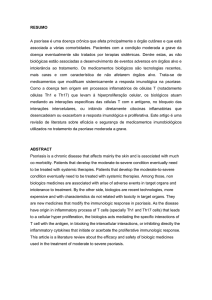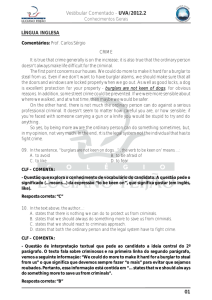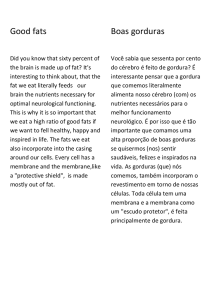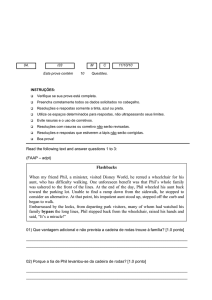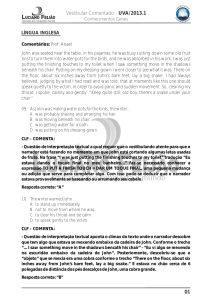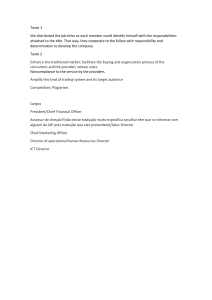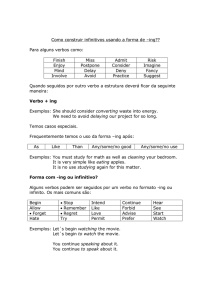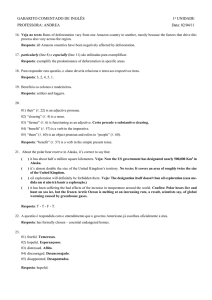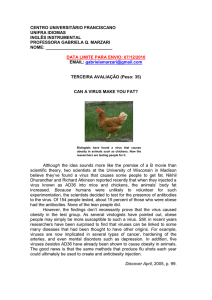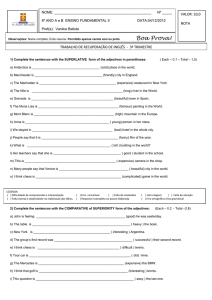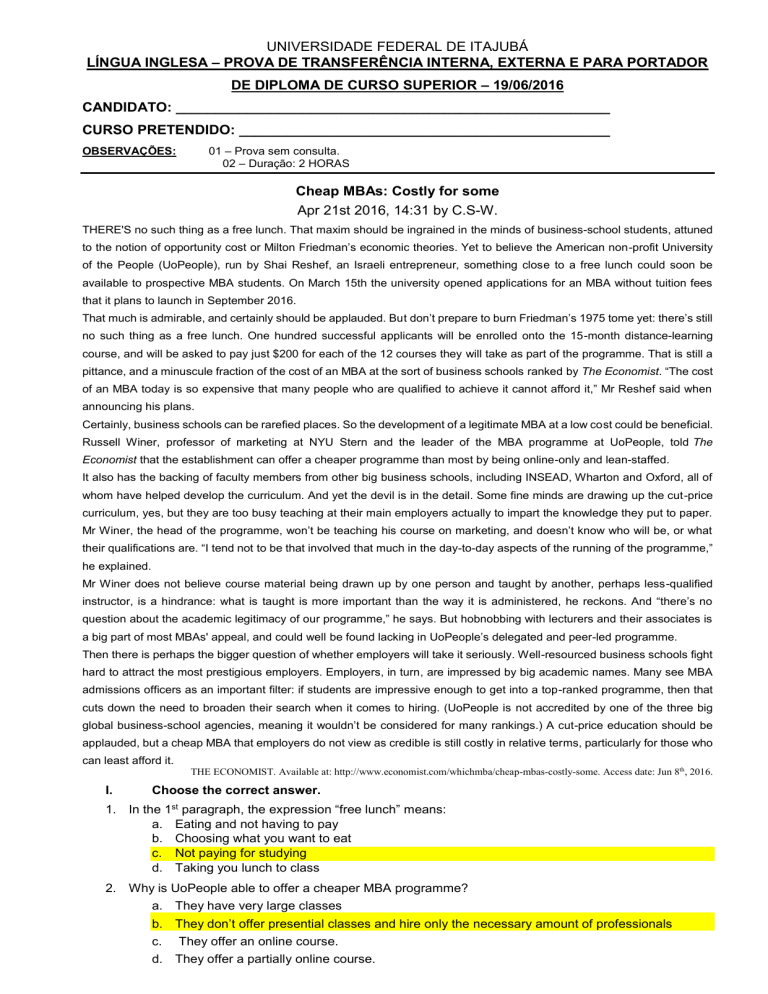
UNIVERSIDADE FEDERAL DE ITAJUBÁ
LÍNGUA INGLESA – PROVA DE TRANSFERÊNCIA INTERNA, EXTERNA E PARA PORTADOR
DE DIPLOMA DE CURSO SUPERIOR – 19/06/2016
CANDIDATO: _______________________________________________________
CURSO PRETENDIDO: _______________________________________________
01 – Prova sem consulta.
02 – Duração: 2 HORAS
OBSERVAÇÕES:
Cheap MBAs: Costly for some
Apr 21st 2016, 14:31 by C.S-W.
THERE'S no such thing as a free lunch. That maxim should be ingrained in the minds of business-school students, attuned
to the notion of opportunity cost or Milton Friedman’s economic theories. Yet to believe the American non-profit University
of the People (UoPeople), run by Shai Reshef, an Israeli entrepreneur, something close to a free lunch could soon be
available to prospective MBA students. On March 15th the university opened applications for an MBA without tuition fees
that it plans to launch in September 2016.
That much is admirable, and certainly should be applauded. But don’t prepare to burn Friedman’s 1975 tome yet: there’s still
no such thing as a free lunch. One hundred successful applicants will be enrolled onto the 15-month distance-learning
course, and will be asked to pay just $200 for each of the 12 courses they will take as part of the programme. That is still a
pittance, and a minuscule fraction of the cost of an MBA at the sort of business schools ranked by The Economist. “The cost
of an MBA today is so expensive that many people who are qualified to achieve it cannot afford it,” Mr Reshef said when
announcing his plans.
Certainly, business schools can be rarefied places. So the development of a legitimate MBA at a low cost could be beneficial.
Russell Winer, professor of marketing at NYU Stern and the leader of the MBA programme at UoPeople, told The
Economist that the establishment can offer a cheaper programme than most by being online-only and lean-staffed.
It also has the backing of faculty members from other big business schools, including INSEAD, Wharton and Oxford, all of
whom have helped develop the curriculum. And yet the devil is in the detail. Some fine minds are drawing up the cut-price
curriculum, yes, but they are too busy teaching at their main employers actually to impart the knowledge they put to paper.
Mr Winer, the head of the programme, won’t be teaching his course on marketing, and doesn’t know who will be, or what
their qualifications are. “I tend not to be that involved that much in the day-to-day aspects of the running of the programme,”
he explained.
Mr Winer does not believe course material being drawn up by one person and taught by another, perhaps less-qualified
instructor, is a hindrance: what is taught is more important than the way it is administered, he reckons. And “there’s no
question about the academic legitimacy of our programme,” he says. But hobnobbing with lecturers and their associates is
a big part of most MBAs' appeal, and could well be found lacking in UoPeople’s delegated and peer-led programme.
Then there is perhaps the bigger question of whether employers will take it seriously. Well-resourced business schools fight
hard to attract the most prestigious employers. Employers, in turn, are impressed by big academic names. Many see MBA
admissions officers as an important filter: if students are impressive enough to get into a top-ranked programme, then that
cuts down the need to broaden their search when it comes to hiring. (UoPeople is not accredited by one of the three big
global business-school agencies, meaning it wouldn’t be considered for many rankings.) A cut-price education should be
applauded, but a cheap MBA that employers do not view as credible is still costly in relative terms, particularly for those who
can least afford it.
THE ECONOMIST. Available at: http://www.economist.com/whichmba/cheap-mbas-costly-some. Access date: Jun 8th, 2016.
I.
Choose the correct answer.
1. In the 1st paragraph, the expression “free lunch” means:
a. Eating and not having to pay
b. Choosing what you want to eat
c. Not paying for studying
d. Taking you lunch to class
2. Why is UoPeople able to offer a cheaper MBA programme?
a. They have very large classes
b. They don’t offer presential classes and hire only the necessary amount of professionals
c.
They offer an online course.
d. They offer a partially online course.
3. In relation to UoPeople MBA programme curriculum, it can be said that
a. It is the same of INSEAD, Wharton and Oxford
b. It is being prepared by experienced faculty but taught by others who may have less
qualifications.
c. Its development is being outsourced to a specialized company.
d. Faculty members don’t know how to develop it.
4. In the end of paragraph 5, the author says “But hobnobbing with lecturers and their associates is a big
part of most MBAs' appeal, and could well be found lacking in UoPeople’s delegated and peer-led
programme.” What does he mean?
a. It is important to have face-to-face contact with the professors.
b. It is not important to have face-to-face contact with the professors.
c.
Associates are not part of the programme.
d. Lecturers are not part of the programme.
5. How do employers see job applicants who have taken an MBA in a ranked programme?
a. They don’t consider the degree as relevant.
b. They believe they are the same as other applicants.
c. They consider they are credible.
d. They believe they have already passed through a rigorous selective process.
II.
Answer the questions below in English
1. Explain why some people qualified for taking an MBA do not enroll in the courses.
Respostas que contenham a ideia Because it’s (so) expensive that they can’t afford it.
2. What does the author mean by “business schools can be rarefied places”?
Respostas que contenham a ideia Because they are expensive and very few people can
afford them/Pay to study there
3. Whats is Mr Winer’s opinion about having the curriculum and course contents developed by one
person and taught by another?
Respostas que contenham a ideia: For him it’s not a problem, because he thinks what is
taught is more importante than how it is taught.
4. Why does the author doubt employers will take the course described seriously?
Respostas que contenham a ideias : Because the course/programme offered by UoPeople is not
top-ranked.
Também é aceitável: Because is is online learning./ Because the teachers (professors) who
develop the curriculum will not teach.
5. Why does the author say thas “a cheap MBA that employers do not view as credible is still costly in
relative terms”?
Respostas com a ideia: Because people who take this course may not get a job/a good job.
UNIFEI - UNIVERSIDADE FEDERAL DE ITAJUBÁ
MATEMÁTICA
PROVA DE TRANSFERÊNCIA INTERNA, EXTERNA E PARA
PORTADOR DE DIPLOMA DE CURSO SUPERIOR - 19/06/2016
CANDIDATO:
CURSO PRETENDIDO:
OBSERVAÇÕES:
1.
2.
3.
4.
5.
Prova SEM consulta;
A prova PODE ser feita a lápis;
PROIBIDO o uso de calculadoras e similares;
Duração: 2 HORAS.
Nas questões discursivas EXPLICITAR os cálculos.
Questão 1 (10 pontos). O gráfico da função do segundo grau f(x) = ax2 + 2bx + c
passa pelo ponto (0, 1) e tem um máximo em (1, 4) então, os valores de a, b e c são
respectivamente
a) −1, 0 e 1
b) 1, 1 e 3
c) 3, −3 e 1
d) −3, 3 e 1
Resposta: d)
Avaliando a função em x = 0 obtemos c = 1. Derivando temos f ′ (x) = 2ax + 2b, para
que x = 1 seja ponto de máximo devemos ter f ′ (1) = 0, daı́ temos b = −a. Avaliando a
função em x = 1 obtemos a − 2a + 1 = 4, donde a = −3. Logo, os valores são −3, 3 e 1,
respectivamente.
Questão 2 (10 pontos).
solução da inequação
Dadas as funções f(x) = x + 3 e g(x) = x − 2, o conjunto
f(x)
≤0
g(x)
é dado por
a) (−∞, −3)
b) [−3, 2]
c) [−3, 2)
d) (2, +∞)
Resposta: c)
Primeiramente note que o quociente das funções não está definido em x = 2. Os sinais
são
f(x) < 0 ⇔ x ∈ S1 = {x ∈ R|x < −3}
f(x) ≥ 0 ⇔ x ∈ S2 = {x ∈ R|x ≥ −3}
g(x) < 0 ⇔ x ∈ S3 = {x ∈ R|x < 2}
g(x) ≥ 0 ⇔ x ∈ S4 = {x ∈ R|x ≥ 2}
como queremos o quociente negativo ou nulo de vemos tomar S2 ∩ S3 = [−3, 2).
Questão 3 (10 pontos).
Avalie
t2 − 1
lim
t→1 t + 1
a) 0
b) +∞
c) 2
d) @
Resposta: a)
Note a função está definida em t = 1 além disto é função racional, logo basta avaliar no
ponto
t2 − 1
lim
= 0.
t→1 t + 1
Questão 4 (10 pontos).
Considere o sistema de equações
2x − 3y = 0
x−y−z=0
−2x + 2y − cz = 0
O valor de c que torna o sistema possı́vel e indeterminado é:
a) 3
b) −2
c) 2
d) 4
Resposta: b)
O determinante associado ao sistema é dado por −5c−10, para que este seja nulo devemos
ter c = −2.
Questão 5 (10 pontos).
x ∈ [−1, 1].
Encontre o ponto de máximo para função f(x) = x3 − x para
√
a) x = 0
b) x =
3
3
√
c) x = −
3
3
d) x = 1
Resposta: c)
Os pontos crı́ticos da função são as soluções de f ′ (x) = 0, visto que f é polinomial.
√
3
′
2
f (x) = 3x − 1 = 0 ⇔ x = ±
3
Avaliando
a função nos pontos crı́ticos e extremos vemos que o ponto de máximo é
√
3
x=− 3 .
Questão 6 (10 pontos). Uma empresa produz diariamente x calças a uma função
custo C(x) = 400 + 30x dinheiros. Considerando que as calças serão vendidas a um valor
2
fixo e inteiro de dinheiros, qual a menor valor de venda para que a empresa tenha lucro
vendendo 40 calças por dia?
Resposta:
Chamando a receita de R(x) = ax. Igualando a receita com o custo na produção de 40
calças temos equilı́brio, receita igual a custo, em a = 40. Daı́ a calça deve custar mais
de quarenta dinheiros.
Questão 7 (10 pontos). O custo total para produzir x unidades de certo produto
é C(x) = 2x2 + 4x + 20 dinheiros. Se o produto é vendido 20 dinheiros e supondo que
toda a produção é absorvida, determine quantas unidades devem ser vendidas para que
o lucro seja máximo.
Resposta:
A função lucro será receita 20x menos a função custo, logo
L(x) = 16x − 2x2 − 20.
Derivando temos, L ′ (x) = −4x + 16, assim o ponto crı́tico é x = 4. Tomando a derivada
segunda obtemos L ′′ (x) = −4 < 0. Assim x = 4 é ponto de máximo.
Questão 8 (10 pontos).
Determine o conjunto solução do sistema
{
(x − 2)|x + 1| < 0
4x − 14 ≤ x − 5
Resposta:
A inequação (x − 2)|x + 1| < 0 tem solução x < 2 com x ̸= −1,
S1 = {x ∈ R|x < 2} ∩ {x ∈ R|x ̸= −1}
e a segunda inequação tem solução
S2 = {x ∈ R|x ≤ 3}
Logo, a solução é S1 ∩ S2 .
Questão 9 (10 pontos).
Calcule
√
x−7
√ .
lim √
x→7
x + 7 − 14
Resposta:
3
Racionalizando o numerador e denominador, temos
√
√
x−7
x + 7 + 14 √
√ = lim √
√
lim √
= 2
x→7
x + 7 − 14 x→7
x+ 7
Questão 10 (10 pontos).
Encontre o conjunto solução sistema
x + y − z = 2
2x + 2y + z = 3
x+y+z=1
Resposta:
Somando a primeira e a última obtemos 2x + 2y = 3 subtraindo este da segunda temos
z = 0, inserindo z = 0 nas equações vemos que x + y = 2 e x + y = 1 que não possui
solução, logo o conjunto solução do sistema é vazio.
4

